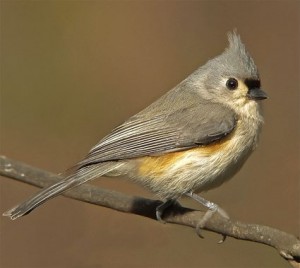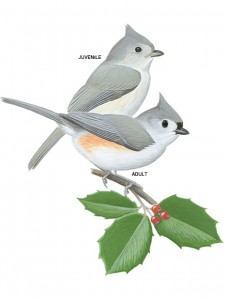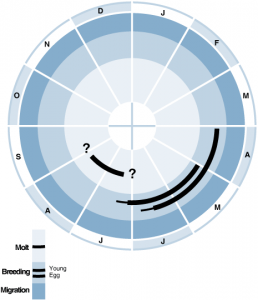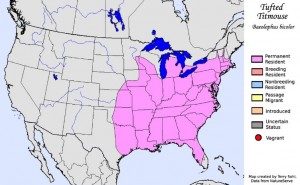What is a Tufted Titmouse?
The Tufted Titmouse (Baeolophus bicolor) is a small bird in the Paridae family. The average male wing span is 79.8mm and average female wing span is 76.7mm. These birds are easily identified with its overall grayish color, with a lighter (white) on the belly and breast and front part of the face behind the beak to their eyes, black forehead, and gray crest. Tufted Titmice also have a distinguishing rusty/oak stripe on their flanks (except the Oak Titmouse (B. inornatus)). In Juvenal plumage, the black on their forehead is diminished so that it may seem to be absent altogether making them appear very similar to a Plain Titmouse. These birds also have small, rounded beaks.
Figure A; Adult Tufted Titmouse (Bolton, 2008). Figure B; Adult and juvenile Tufted Titmice (O’Brien, 2006).
How can we identify Tufted Titmice?
In order to identify a Tufted Titmouse, it is important to look for five characteristics: size and shape, color pattern, behavior, and habitat. Starting with size and shape, a Tufted Titmouse is larger than the birds that come to feeders. It has a large head and eyes, a thick neck, and a full body. If these are difficult to spot, then its pointed crest and stout bill should help to identify it. Next, the color pattern of a Tufted Titmouse is soft silvery gray on the top and white on the bottom, its sides are peach-colored, and there is a small black patch right above the bill. Looking at its behavior, Tufted Titmice often fly with chickadees and woodpeckers, and they regularly visit feeders, dominating smaller birds. Finally, the Tufted Titmice are usually found in woodlands, with deciduous and evergreen forests. However, do not worry if you do not live in woodlands because Tufted Titmice are common at feeders and they are found in backyards and parks.
Where do Tufted Titmice breed and live? How do they obtain food?
The Tufted Titmouse breeds from eastern Nebraska to the Gulf Coast of Texas and from Florida to southern Maine. However, it is also found in southern Ontario and Quebec. Tufted Titmice can also be found at feeders or in backyards and parks. The Tufted Titmouse prefers deciduous forests that contain tall plants, a variety of tree species, and dense canopies. It forages in cracks in tree bark, using its bill to open seeds and acorns. It eats mostly seeds, small fruits, and insects, foraging among forest trees. It forages in higher canopies and in the outer part of the tree, rather than the branches, during the summer when there is an abundance of insects. However, in the winter, the Tufted Titmouse relies on the abundance of nuts and nut-bearing trees, like oaks and beeches. Colder weather, however, reduces the Tufted Titmouse’s foraging height, the tree species it chooses, and a decrease in the amount it travels. The Tufted Titmice cache seeds under loose bark, but they also use furrows, cracks, broken and rotted areas of trees, as well as on the ground. Typically, Tufted Titmice also select one seed from a feeder at a time. They remove the shell and hide the kernel within 130 feet of the feeder.
After wandering through fall and winter in small flocks, the Tufted Titmice begin breeding in spring and separate into pairs. Generally, males chase females along branches and end up in bush piles. Males are aggressive and dominant throughout the year over their mates and other females. Pairing of the Tufted Titmice lasts throughout their lifetime and they both defend their territory throughout the year. Immature birds show interest in nests during their first year and the female makes the nest alone. Courtship occurs from the time the nest is chosen to the second day of hatching. Creating the nest may take six to eleven days and the eggs are laid in the nest before the female leaves the nest in the morning. Four to eight eggs are normally found in the nest. The incubation period for females is approximately 13 days and the nestling period is about 17 days. Offspring are fed until they are 36 days old and they beg until they are 64 days old (Brackbill, 1970). Some offspring remain with their parents to help with the next brooding season. Song is inherited from both sexes, but it is primarily learned from the male and it is most likely heard throughout the year. The breeding behavior of the Tufted Titmice is very similar to the Black-crested Titmice. Interestingly, the Black-crested Titmouse has been considered to be a type of a Tufted Titmouse. The two species actually hybridize when they meet, however the hybrid zone is very narrow. They have similar calls, however they have genetic differences.
How do Tufted Titmice communicate?
Tufted Titmice are highly intelligent, active birds that are often spotted in trees and hanging upside down looking for insects beneath twigs. They are most active during the day and they, generally, do not migrate extensively, remaining in one location throughout the winter. They can be trained to listen to the commands of human voices and take food from the hands of humans. Tufted titmice are social birds that are usually in pairs or small flocks. After the mating season, they may join flocks of chickadees and nuthatches. They are active foragers and cache seeds in the ground and they often store food under bark or under objects on the ground. When building their nests, they may pluck fur or hair from animals or humans. Tufted Titmice often create their nest in tree holes, but they cannot create their own nest cavities and they use natural holes or cavities left by woodpeckers. These species’ dependence on dead wood for their homes is one reason why it’s important to allow dead trees to remain in forests rather than cutting them down.
How about Tufted Titmice in Vassar?
In Dutchess County, it actively flies from branch to branch and jumps along branches, while it hops on the ground. It hangs upside down on branches. Males sing often and will display antagonistic behavior towards intruders or other males. The Tufted Titmice usually live in pairs.
What can we do in the future?
Currently, the Tufted Titmouse has been expanding northward over the last 50 years. This is possibly a result of global warming, human interference in woodlands, and the growing popularity of backyard bird feeders. Future research should focus on the new migration patterns of Tufted Titmice. An observational study can be used, in which select groups of Tufted Titmice can be tagged with GPS technology. The migratory patterns of the select Tufted Titmice can then be observed.
Authors: Abhideep Singh and Alexandra Frazier
Sources
Brackbill, H. 1970. Tufted Titmouse Breeding Behavior. The Auk, 87, 522-536.
Bolton, K. “Tufted Titmouse.” Identification, All About Birds. 2006. Web.
O’Brien, M. “Tufted Titmouse, Tufted Titmouse Pictures, Tufted Titmouse Facts – National Geographic.” National Geographic. 2006.
Sibley, D.A., 2000. National Audubon Society – The Sibley Guide to Birds. New York: Chanticleer Press Inc.





I live in Norfolk County in Massachusetts, and I see these birds all the time. My family has a bird feeder outside and often times, a tufted titmouse will fly near and take a few bites. They’re really sweet looking, they’re my favorite bird. I’m sorry that this comment isn’t very educational, but I wanted to share my experiences with these little birds. They’re nice and I’m excited to learn about them.
I just had an encounter with a titmouse on the northern Minnesota border and Canada on Rainy Lake. Oct 30, 2018. I was walking in a scrub oak plot and close to a small crabapple tree full of tiny red apples when I heard a tweet of alarm. At the same instant there was movement 20 feet to my right and a 10 point white tail buck jolted in alarm and froze. We all stared at each other around the tree for approximately 2 minutes and then I walked away and left them alone